Mulch, a common term in horticulture, refers to a layer of material spread on top of the soil around plants. Its primary purpose is to conserve soil moisture, suppress weed growth, and as it decomposites, enhance the fertility and structure of the soil. While commonly associated with outdoor gardening, mulching also plays a significant role in indoor plant care. Scientists from the University of Florida IFAS Extension have indicated that organic mulch like compost or bark can enhance the soil’s ability to retain moisture and improve its structure, benefiting the overall health of indoor plants.
The best mulch for indoor plants largely depends on the plant species, its unique requirements, and the owner’s aesthetic preferences. For instance, tropical indoor plants may thrive with organic mulch like compost due to its ability to retain moisture, while succulents may prefer inorganic mulch like sand for enhanced drainage.
In this article, we’ll take a comprehensive look at different types of mulch suitable for indoor plants, their pros and cons, and how to select and apply them. We will also address potential risks and precautions when using mulch for indoor plants. The insights presented are based on scientific facts and expert opinions to help you make an informed decision and better care for your indoor plants.
What is Mulch and Why is it Crucial for Indoor Plants?
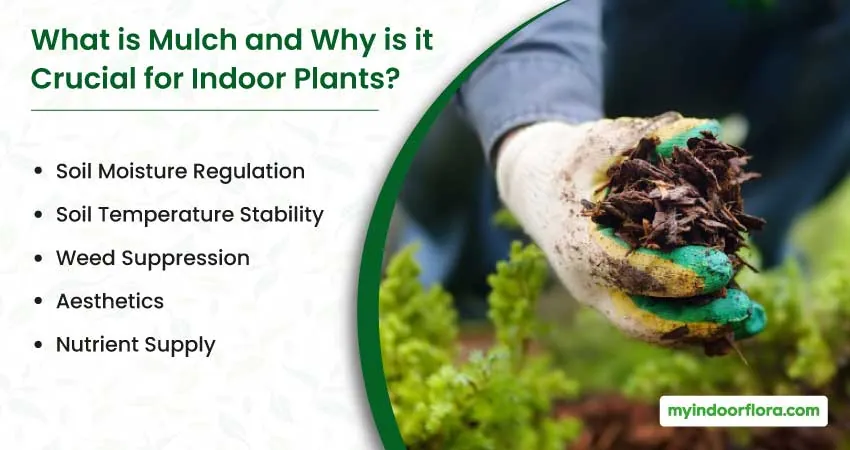
Mulch, in the simplest of terms, is any material that is spread or laid over the surface of the soil as a covering. It plays an instrumental role in managing the soil’s environment and maintaining plant health, both outdoors and indoors. For indoor plants specifically, mulch serves as an effective tool to address some unique challenges they face, stemming from their confinement within pots and the regulated indoor environment.
Soil Moisture Regulation
One of the primary functions of mulch is to regulate soil moisture. It slows down the evaporation process, helping the soil retain moisture for longer periods. This is particularly beneficial for indoor plants as they often struggle with drying out too quickly due to indoor heating or cooling systems.
Soil Temperature Stability
Temperature fluctuations can stress indoor plants. Mulch acts as an insulator, creating a barrier between the soil and the external environment. This helps maintain a more consistent soil temperature, which is essential for root health and nutrient uptake.
Weed Suppression
Although less common for indoor plants, weed growth can still occur. Mulch provides a physical barrier that makes it harder for weed seeds to reach the soil and germinate.
Aesthetics
Apart from functional benefits, mulch also adds to the aesthetic appeal of indoor plants. Available in various colors, textures, and materials, mulch can complement your plant and pot, contributing to the overall décor of your space.
Nutrient Supply
Certain types of organic mulch gradually decompose, releasing nutrients into the soil. This slow release of nutrients can supplement your indoor plants’ feeding schedule, ensuring they remain healthy and vibrant.
Different Types of Mulch Suitable for Indoor Plants
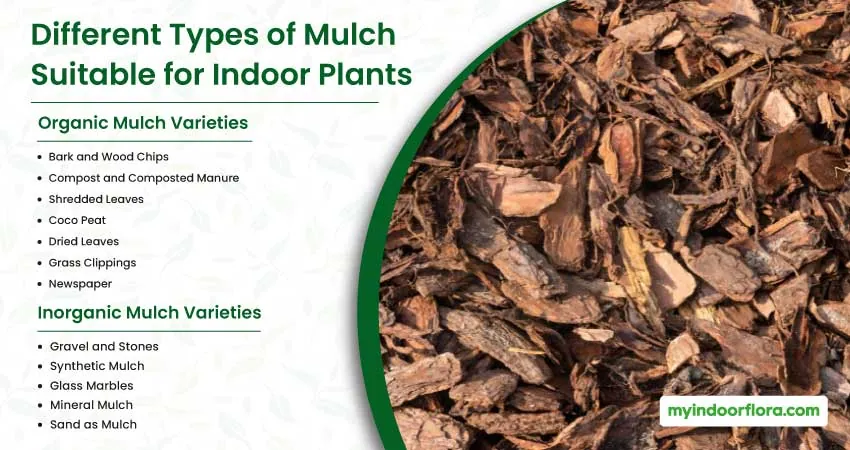
Choosing the right mulch for indoor plants is a crucial factor in achieving a thriving indoor garden. Generally, mulches can be divided into two main categories: organic and inorganic. Each type has specific characteristics, and their suitability depends on the unique needs of your indoor plants. Let’s delve deeper into the most common types within these categories.
Organic Mulch Varieties
Organic mulches are derived from materials that were once alive, like wood chips, bark, leaves, straw, or compost. They have a two-fold purpose, acting as a mulch while enhancing soil condition over time as they decompose.
1. Bark and Wood Chips
Derived from various types of trees, bark and wood chips are a popular choice for mulching indoor plants. They are available in many sizes and colors, providing a natural and pleasing appearance. They decompose slowly, making them a durable choice that doesn’t require frequent replenishment.
| Pros | Cons |
|---|---|
| Aesthetically pleasing, excellent at maintaining soil moisture and temperature, low-maintenance due to slow decomposition | Can deplete nitrogen from the soil as they decompose, may harbor certain pests |
2. Compost and Composted Manure
Compost and composted manure are nutrient-dense organic materials that can significantly enrich your indoor plant soil. These options are like a double-edged sword, providing mulching benefits while slowly releasing essential nutrients.
| Pros | Cons |
|---|---|
| Nutrient-rich, improves soil structure, acts as a slow-release fertilizer | Decomposes quickly requiring frequent replenishment, if not properly composted, they may attract pests |
3. Shredded Leaves
Shredded leaves, a readily available and cost-effective option, can be an excellent organic mulch if you have access to them. They decompose to provide beneficial organic matter and nutrients to the soil.
| Pros | Cons |
|---|---|
| Cost-effective, contributes organic matter to the soil as it decomposes | Decomposes faster than bark, can inhibit water penetration if applied too thickly |
4. Coco Peat
Coco peat, derived from the husk of coconuts, is a lightweight mulch that excels at moisture retention. It can also improve soil aeration and is pH neutral.
| Pros | Cons |
|---|---|
| Excellent at retaining moisture, lightweight, pH neutral, improves soil aeration | Can become water-repellent if allowed to dry out completely, doesn’t contribute significant nutrients to the soil |
5. Dried Leaves
Dried leaves, similar to shredded leaves, are an organic mulch option that can be used effectively for indoor plants. They can be collected and dried from your garden or nearby trees.
| Pros | Cons |
|---|---|
| Easily available, adds organic matter to the soil upon decomposition, cost-effective | Decomposes relatively quickly, requiring regular replenishment; may attract insects if not properly dried |
6. Grass Clippings
Grass clippings are another organic mulch that can be sourced right from your garden. They are most effective when dried and broken down into smaller pieces before application.
| Pros | Cons |
|---|---|
| Nutrient-rich, especially in nitrogen; decomposes to enrich the soil; easily available | Can form a thick layer and prevent water penetration if applied excessively; may contain weed seeds |
7. Newspaper
Newspaper, an unconventional choice, can be an effective and readily available mulch. It’s best to use in thin layers and to use only non-glossy, soy-ink printed paper for safety.
| Pros | Cons |
|---|---|
| Readily available, helps retain moisture, decomposes to add organic matter to the soil. | Can be unattractive; ink might be toxic to plants if not soy-based. |
Inorganic Mulch Varieties
In contrast to organic mulches, inorganic options do not decompose or contribute to soil fertility. However, they are long-lasting and can offer unique aesthetic appeal.
1. Gravel and Stones
Gravel and stones are commonly used for indoor plants due to their excellent temperature regulation and moisture conservation properties. They also lend a natural and modern aesthetic to indoor plant arrangements.
| Pros | Cons |
|---|---|
| Excellent temperature regulation and moisture conservation, aesthetic appeal | Heavy, does not improve soil fertility, difficult to remove |
2. Synthetic Mulch
Synthetic mulches made from rubber or plastic are durable and can come in various colors, offering a range of aesthetics.
| Pros | Cons |
|---|---|
| Durable, wide range of aesthetic options | May leach harmful chemicals into the soil, does not contribute to soil health or fertility |
3. Glass Marbles
Glass marbles provide a unique visual appeal and help reduce soil evaporation, maintaining soil moisture effectively.
| Pros | Cons |
|---|---|
| Unique visual appeal, reduces soil evaporation | Minimal impact on soil health, doesn’t provide any additional nutrients |
4. Mineral Mulch
Mineral mulches like perlite, vermiculite, and pumice are inorganic options that are lightweight and can improve soil aeration and moisture retention.
| Pros | Cons |
|---|---|
| Improves soil aeration and moisture retention, lightweight, does not decompose | Does not contribute to soil fertility; can be more expensive than other options |
5. Sand as Mulch
While sand is not traditionally used as a mulch, it can be effective, especially for plants that prefer well-drained conditions like succulents or cacti.
| Pros | Cons |
|---|---|
| Enhances soil drainage, retains heat well, can be aesthetically pleasing with certain plants | Can compact over time, leading to waterlogged soil; does not contribute organic matter or nutrients to the soil |
The best choice of mulch can vary depending on the specific needs of your indoor plants. Understanding the attributes of each type can aid in choosing the mulch that will most effectively benefit your indoor garden.
How to Choose the Best Mulch for Your Indoor Plants?
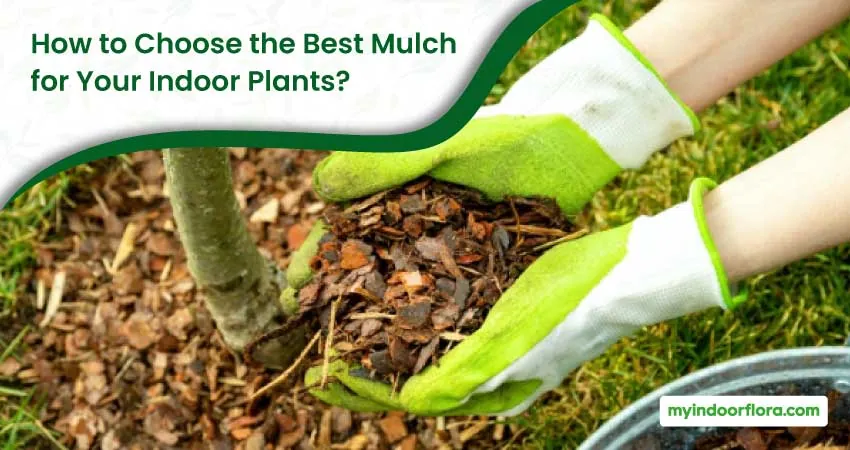
Choosing the right type of mulch for your indoor plants can have a significant impact on their health and growth. Below are some factors to consider to ensure you’re making the best decision.
Plant Types and Their Mulch Preferences
Different plants have different preferences when it comes to mulching. Some plants prefer a certain type of mulch over another due to their specific needs. Let’s dive deeper into the mulching preferences of a few common indoor plant types.
| Plant Type | Mulch Preferences | Reason |
|---|---|---|
| Succulents and Cacti | Gravel, Stones, Glass Marbles | These inorganic mulches help maintain soil moisture without over-saturating, which is beneficial for these plants native to arid regions. |
| Ferns and Leafy Plants | Compost, Shredded Leaves, Coco Peat | These organic mulches help maintain high humidity and enrich the soil, which these plants thrive on. |
| Flowering Indoor Plants | Compost, Composted Manure | Nutrient-rich mulches enrich the soil and promote blooming, beneficial for flowering plants. |
| Indoor Fruiting Plants | Compost, Composted Manure | These plants need nutrient-dense soil to bear fruit, and these types of mulches provide a steady nutrient supply. |
Evaluate the Mulch’s Properties
As we’ve discussed, different mulches have varying properties. Some, like compost, are rich in nutrients, while others, like synthetic mulch or glass marbles, primarily serve aesthetic purposes. Ensure the mulch you choose aligns with your plant’s needs.
Consider the Maintenance Requirement
Some types of mulch, like compost or shredded leaves, break down and enrich the soil but will need regular replenishment. On the other hand, inorganic mulch like stones or synthetic mulch requires less maintenance but does not contribute to soil fertility.
Reflect on Aesthetics
While the health of your plants is paramount, the aesthetic appeal of the mulch should also be considered. Mulch can serve a decorative purpose, enhancing the overall look of your indoor garden.
Consult with Experts
If you’re unsure about the best type of mulch for your plants, don’t hesitate to consult with a local nursery or extension service. They can provide advice tailored to your specific plants and circumstances.
How to Apply Mulch to Indoor Plants?
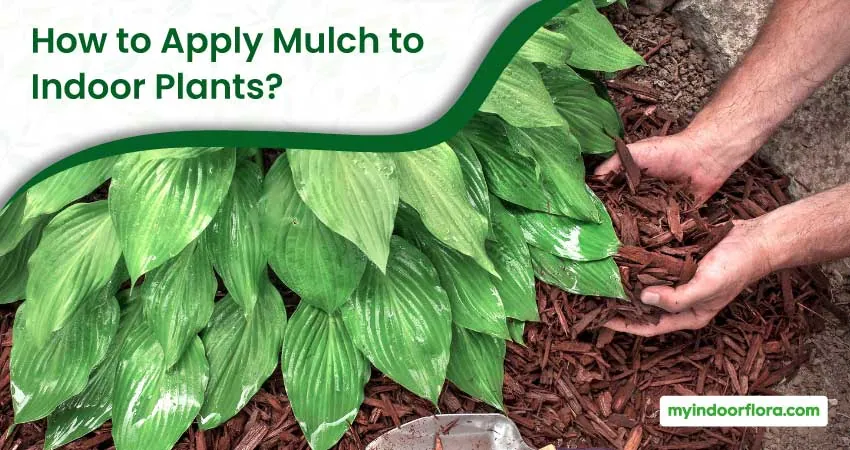
Applying mulch to indoor plants follows a similar procedure as it would in an outdoor setting. Here is a step-by-step guide to help you:
- Clean the Topsoil: Begin by cleaning any debris or old mulch from the topsoil. This ensures that your new mulch layer can function effectively.
- Water the Soil: Before applying mulch, water the soil thoroughly. Mulch helps retain soil moisture, so it’s important to start with adequately hydrated soil.
- Apply the Mulch: Spread a layer of your chosen mulch on the surface of the soil. The layer should be thick enough to inhibit weed growth and retain moisture, typically around 2-3 inches thick.
- Leave Space Around the Stem: It’s important not to mound mulch up around the base of your plant. Leave a little space around the stem to prevent potential issues like rot or pest infestation.
- Water Again: After applying the mulch, water lightly once more to settle it into place.
Remember, each type of mulch may have slightly different application methods. Always do your research and follow any specific instructions for the mulch type you’ve chosen.
Are There Any Risks Associated with Mulching Indoor Plants?
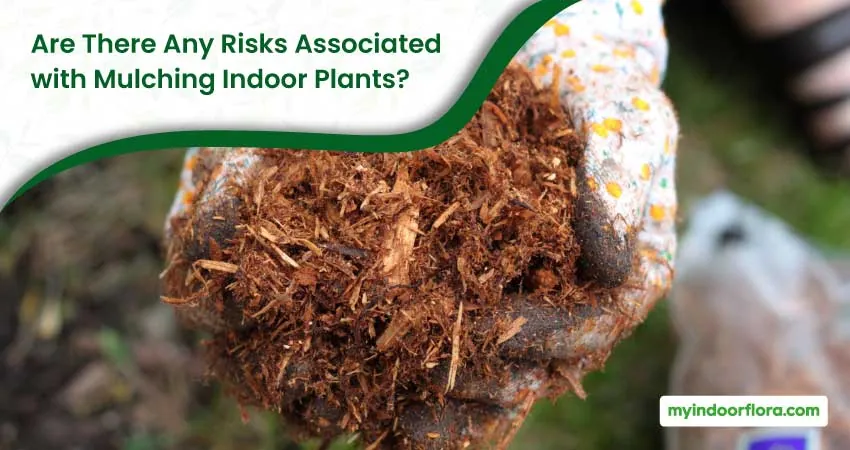
While mulching provides many benefits, it’s important to be aware of potential risks and how to mitigate them.
- Over Mulching: Too much mulch can create a barrier that prevents water and air from reaching the soil. Always apply the appropriate amount of mulch and keep it away from the base of the plant.
- Nitrogen Depletion: Some organic mulches, like wood chips, can deplete nitrogen from the soil as they decompose. Consider adding a nitrogen fertilizer or using a nitrogen-rich mulch like compost or grass clippings.
- Pest Infestation: Certain types of mulch can attract pests, like insects or rodents. Regularly inspect your plants and promptly address any signs of pest activity.
- Mold and Fungal Growth: Moist, dark conditions under mulch can sometimes encourage mold and fungal growth. Ensure your indoor plants are not overwatered and have good air circulation to prevent this.
Are there any Eco-Friendly and Sustainable Mulch Options for Indoor Plants?
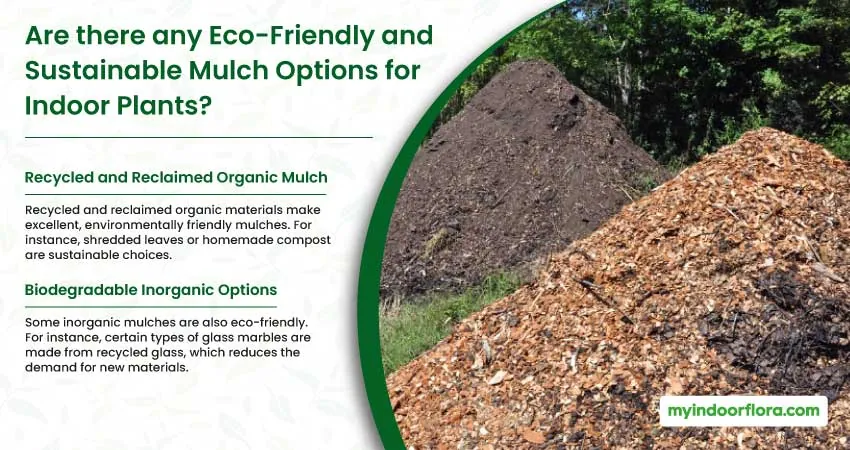
Choosing an eco-friendly mulch option aligns our indoor gardening practice with the broader goal of environmental sustainability.
Recycled and Reclaimed Organic Mulch
Recycled and reclaimed organic materials make excellent, environmentally friendly mulches. For instance, shredded leaves or homemade compost are sustainable choices.
Biodegradable Inorganic Options
Some inorganic mulches are also eco-friendly. For instance, certain types of glass marbles are made from recycled glass, which reduces the demand for new materials.
Frequently Asked Questions
As we wrap up, let’s address some common questions that arise in the context of indoor plant mulching.
Can You Place Mulch at the Bottom of Plant Pots?
The placement of mulch in plant pots is traditionally at the top of the soil, not the bottom. This practice provides the most benefits, including soil moisture retention, weed suppression, and adding organic matter to the soil as the mulch breaks down.
Placing mulch at the bottom of a plant pot could potentially cause drainage issues. Mulch can block the drainage holes and prevent excess water from leaving the pot, which could lead to waterlogging and root rot, common killers of indoor plants.
However, it’s not uncommon to place a layer of inorganic material, such as small stones or pieces of broken pottery, at the bottom of pots before adding soil. This practice, often referred to as crocking, was traditionally done to improve drainage. But many modern gardening experts argue that this practice is unnecessary with today’s well-formulated potting soils and may instead create a perched water table that can harm your plant’s roots. It’s generally recommended to fill your pots with quality potting soil from bottom to top for the best results.
How often should I replace the mulch in my indoor plants?
This largely depends on the type of mulch used. Organic mulch decomposes over time and will need to be replaced as it breaks down. Inorganic mulch lasts longer and only needs replacement if it becomes dirty or discolored.
Can I use outdoor mulch for my indoor plants?
While you can technically use outdoor mulch for indoor plants, it’s crucial to consider factors like aesthetics, potential for pest infestation, and whether the mulch type suits the specific needs of your indoor plants.
How can I prevent pests in my mulch?
Regular inspection and proper cleanliness can help prevent pests in your mulch. If you’re using organic mulch, ensure it’s well-composted to minimize pest attraction.
What are some eco-friendly mulch options?
Shredded leaves, homemade compost, and recycled glass marbles are some examples of eco-friendly mulch options for indoor plants.
In the vast world of indoor gardening, mulching is a tool that helps our plants thrive. It’s about understanding our plants, their needs, and how we can support them in our shared indoor environment. Happy mulching!
